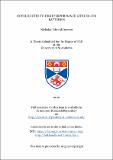Files in this item
Novel routes to high performance lithium-ion batteries
Item metadata
| dc.contributor.advisor | Bruce, Peter G. | |
| dc.contributor.author | Drewett, Nicholas E. | |
| dc.coverage.spatial | 198 | en_US |
| dc.date.accessioned | 2013-05-08T09:07:42Z | |
| dc.date.available | 2013-05-08T09:07:42Z | |
| dc.date.issued | 2013-06-26 | |
| dc.identifier | uk.bl.ethos.572728 | |
| dc.identifier.uri | https://hdl.handle.net/10023/3513 | |
| dc.description.abstract | This thesis investigates several approaches to the development of high-performance batteries. A general background to the field and an introduction to the experimental methods used are given in Chapters 1 and 2 respectively. Chapter 3 presents a study of ordered and disordered LiNi₀.₅Mn₁.₅O₄ materials produced using an optimised resorcinol-formaldehyde gel (R-F gel) synthetic technique. Both materials exhibited good electrochemical properties and minimal side reaction with the electrolyte. Structural analyses of the materials in various states of discharge and charge were undertaken, and from these the charge / discharge processes were elucidated. In chapter 4 R-F gel synthesised Li(Ni₁/₃Mn₁/₃Co₁/₃)O₂ is studied and found to exhibit a high degree of structural stability on cycling, as well as excellent capacity, cyclability and rate capability. Photoelectron spectroscopy studies revealed that the R-F gel derived particles have highly stable surfaces. A discussion of the results and their significance, with particular regard to the outstanding electrochemical performance observed, is also presented. Chapter 5 sets out an investigation into the nature of R-F gel synthesised 0.5Li₂MnO₃:0.5LiNi₁/₃Mn₁/₃Co₁/₃O₂. The electrochemical data revealed that, after an initial activation stage, the R-F gel derived material exhibited a high capacity, good cyclability and exceptional rate capability. This chapter also considers some initial structural investigations and the electrochemical processes occurring on charge. In chapter 6 the use of ether-based electrolytes, combined with various cathode materials, in lithium-oxygen batteries is examined. The formation of decomposition products was observed, and a scheme suggesting probable reaction pathways is given. It was noted that significant quantities of the desired discharge product, lithium peroxide, were formed on the 1st cycle discharge, implying some electrolyte / cathode combinations do demonstrate a degree of stability. A summary of the results and a discussion of their significance are also included. | en_US |
| dc.language.iso | en | en_US |
| dc.publisher | University of St Andrews | |
| dc.subject | Li-ion batteries | en_US |
| dc.subject | Cathodes | en_US |
| dc.subject | Lithium air | en_US |
| dc.subject | Cyclability | en_US |
| dc.subject.lcc | TK2945.L58D8 | |
| dc.subject.lcsh | Lithium ion batteries | en_US |
| dc.subject.lcsh | Cathodes--Materials | en_US |
| dc.title | Novel routes to high performance lithium-ion batteries | en_US |
| dc.type | Thesis | en_US |
| dc.type.qualificationlevel | Doctoral | en_US |
| dc.type.qualificationname | PhD Doctor of Philosophy | en_US |
| dc.publisher.institution | The University of St Andrews | en_US |
| dc.identifier.doi | https://doi.org/10.17630/10023-3513 |
This item appears in the following Collection(s)
Items in the St Andrews Research Repository are protected by copyright, with all rights reserved, unless otherwise indicated.

